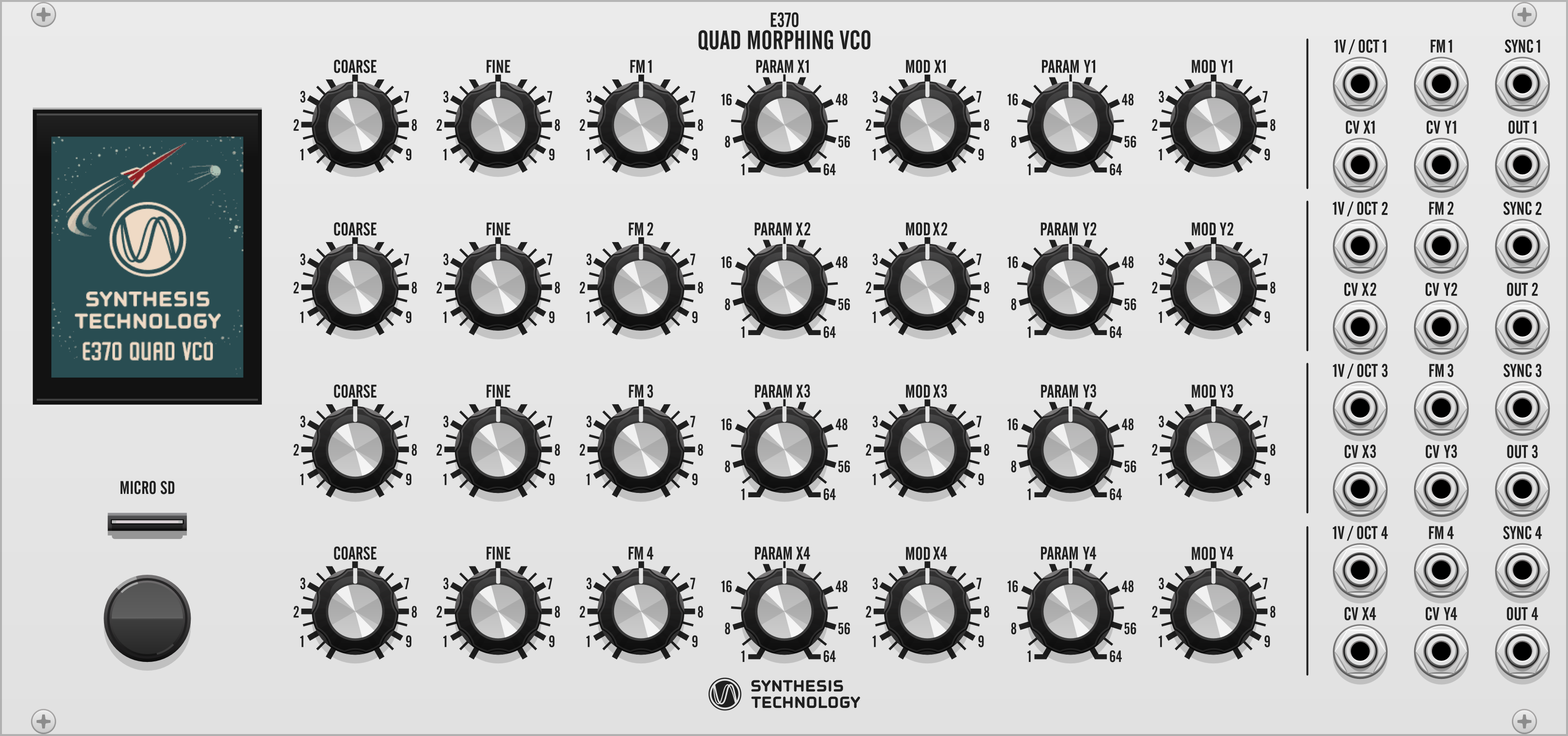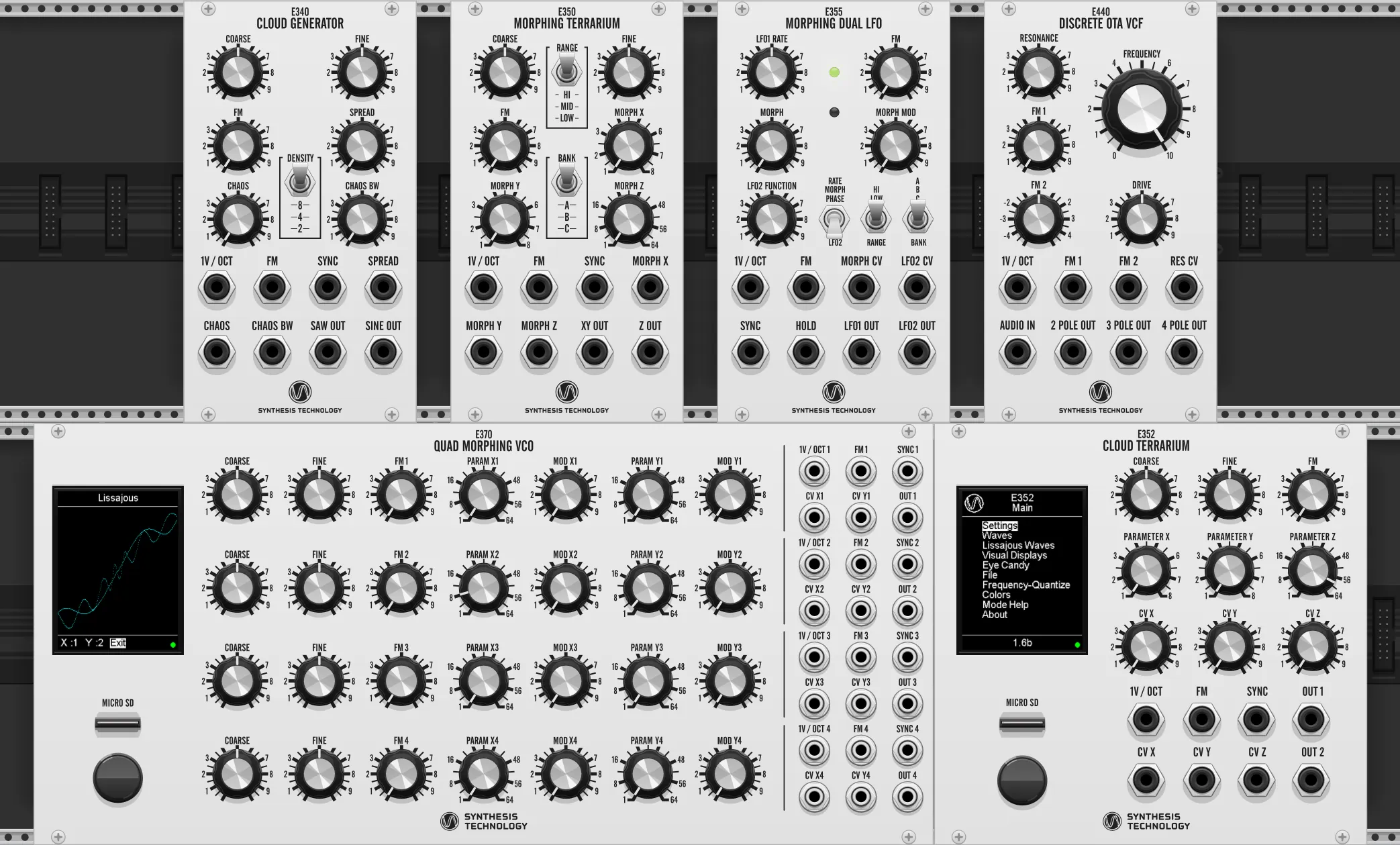
Authentic re-creations of Synthesis Technology Eurorack modules
Accurate DSP models of analog circuitry
E370 Quad Morphing VCO
The Synthesis Technology E370 hardware Eurorack module was the result of a successful Kickstarter campaign in 2017. We bring this module to VCV Rack, including the original firmware and all features of the hardware, plus convenience enhancements such as a clickable screen, SD card folder emulation, and support for Rack’s 16-voice polyphonic cables.
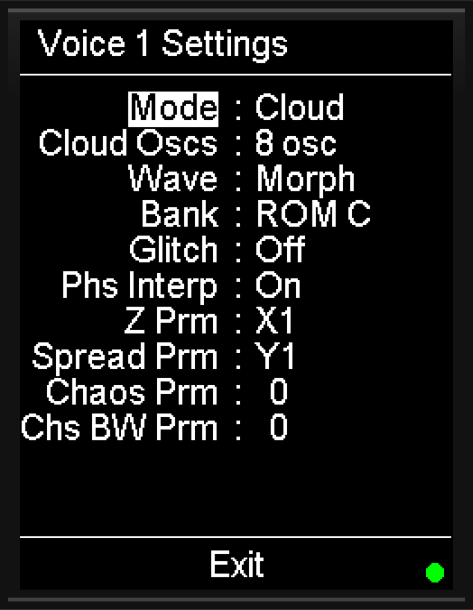
E370 contains 4 independently-controlled DSP-based oscillators, each with several algorithms:
- MorphXY: Scans (morphs) a 2D 8×8 wavetable with smooth interpolation or 3 levels of glitching.
- MorphZ + Phase: Scans a 1D 64-wave wavetable with optional phase shift and amplitude control.
- MorphZ + Wavefolder: Scans a 1D 64-wave wavetable with a Chebyshev wavefolder.
- MorphZ + Sub: Scans a 1D 64-wave wavetable with a sub oscillator.
- MorphZ + Chord: Scans a 1D 64-wave wavetable with selectable chord from table up to 4 notes.
- Cloud: Creates 2, 4, or 8 copies of a wave and detunes them with Spread or lowpass-filtered noise FM. Can use standard waveforms (Sine, Tri, Saw, Square) or a morphed wavetable.
- 2-Op FM: 2-operator frequency modulation with standard waveforms or morphed wavetable. Control FM depth and quantized frequency ratio between modulator and carrier.
- Noise: 4 types of noise with optional 4-pole resonant lowpass filter.
- Sample Player: Plays the entire wavetable in one shot when SYNC is triggered.

You can navigate E370’s menu by clicking/dragging directly on the screen, or by clicking/dragging the encoder knob.
To load a custom wavetable, click the microSD card slot and select a folder location using the dialog.
Navigate to the File menu on the screen and select a WAV file.
WAVs must contain 64 wave cycles of 256 samples each (16-bit).
Example files are provided in the banks/ folder, matching the built-in ROM A/B/C.

Synthesis Technology WaveEdit (for Windows, Mac, and Linux) was designed for users to create their own wavetables for E370/E352. A collection of 715 wavetables was created by WaveEdit users and released into the public domain.
Polyphonic cables can be patched into 1V/oct pitch inputs, generating polyphonic audio output. Up to 16 polyphonic channels can be used per section. Using all 4 sections and 8 oscillators in Cloud mode, one instance of E370 can render up to 512 waveforms simultaneously!
This VCV Rack software module uses the original firmware from the hardware Synthesis Technology E370 module. See its manual (PDF) for full details.

E352 Cloud Terrarium
The Synthesis Technology E352 is a dual-output variant of E370 Quad Morphing VCO and the successor of E340 Cloud Generator and E350 Morphing Terrarium.
E352 contains most oscillator algorithms from E370, in addition to:
- Morph + Detune: Output 2 is detuned from Output 1 by Parameter X, using several detuning modes.
- Morph + Blend: Two different morphed waveforms can be blended (mixed) by Parameter X.
This VCV Rack software module uses the original firmware from the hardware Synthesis Technology E352 module. See its manual (PDF) for full details.
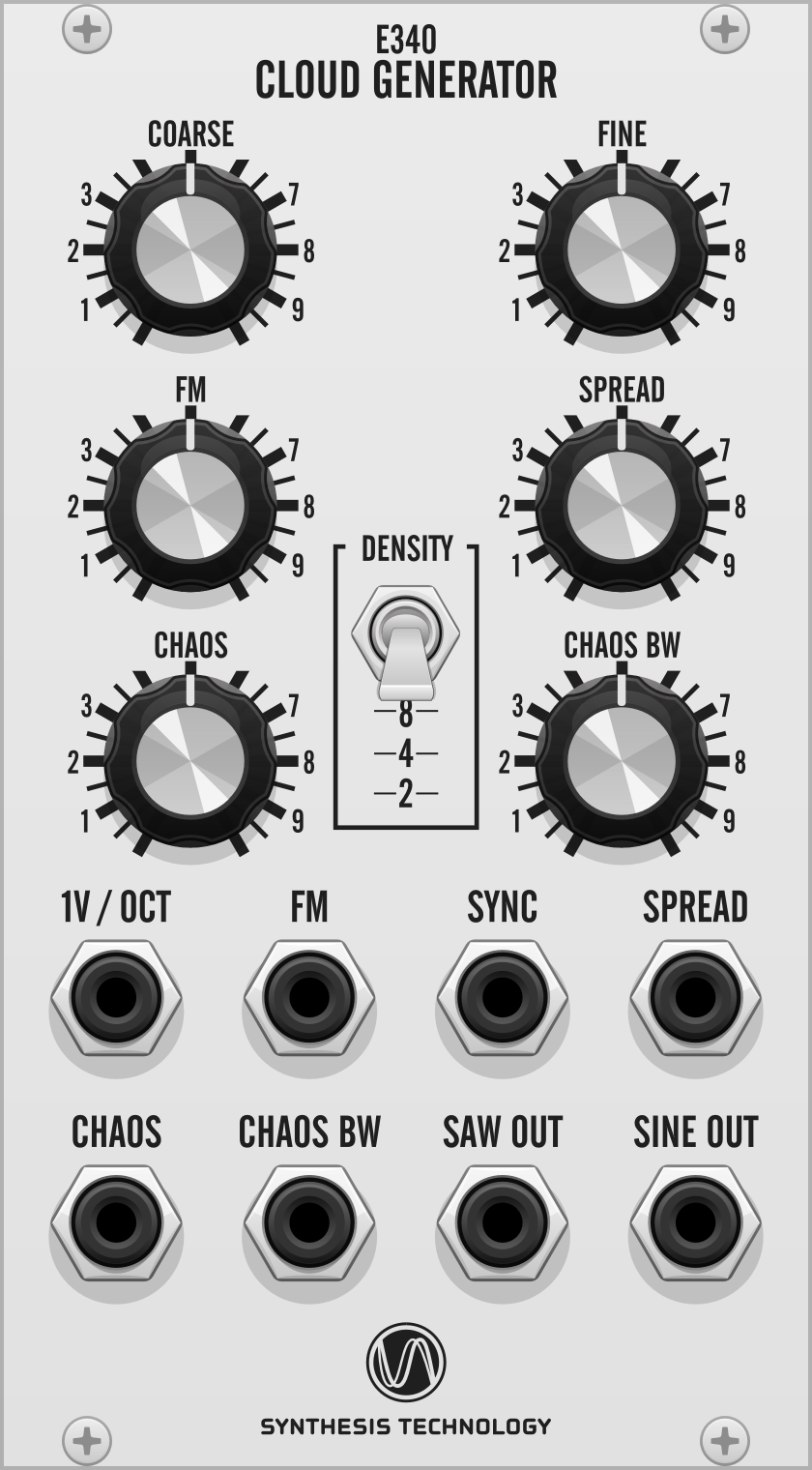
E340 Cloud Generator
The Synthesis Technology E340 is a super-saw/sine oscillator capable of generating up to 8 waveforms per output. If you want massive bass and lead voices like the JP-8000 supersaw, or thick ambient drones as if played from a slow rotary speaker, the E340 is the perfect audio source for your synth patches.
Detune the swarm of oscillators using SPREAD or with randomly filtered noise using CHAOS and CHAOS BW (bandwidth). Reset the phase of all waveforms using the SYNC trigger input, which can use another oscillator to produce a sync-lead sound.
This module supports VCV Rack’s polyphonic cables, so with 16 voices, you can generate a total of 128 waveforms per output.
This VCV Rack software module uses the original firmware from the hardware Synthesis Technology E340 module. See its manual (PDF) for more details.
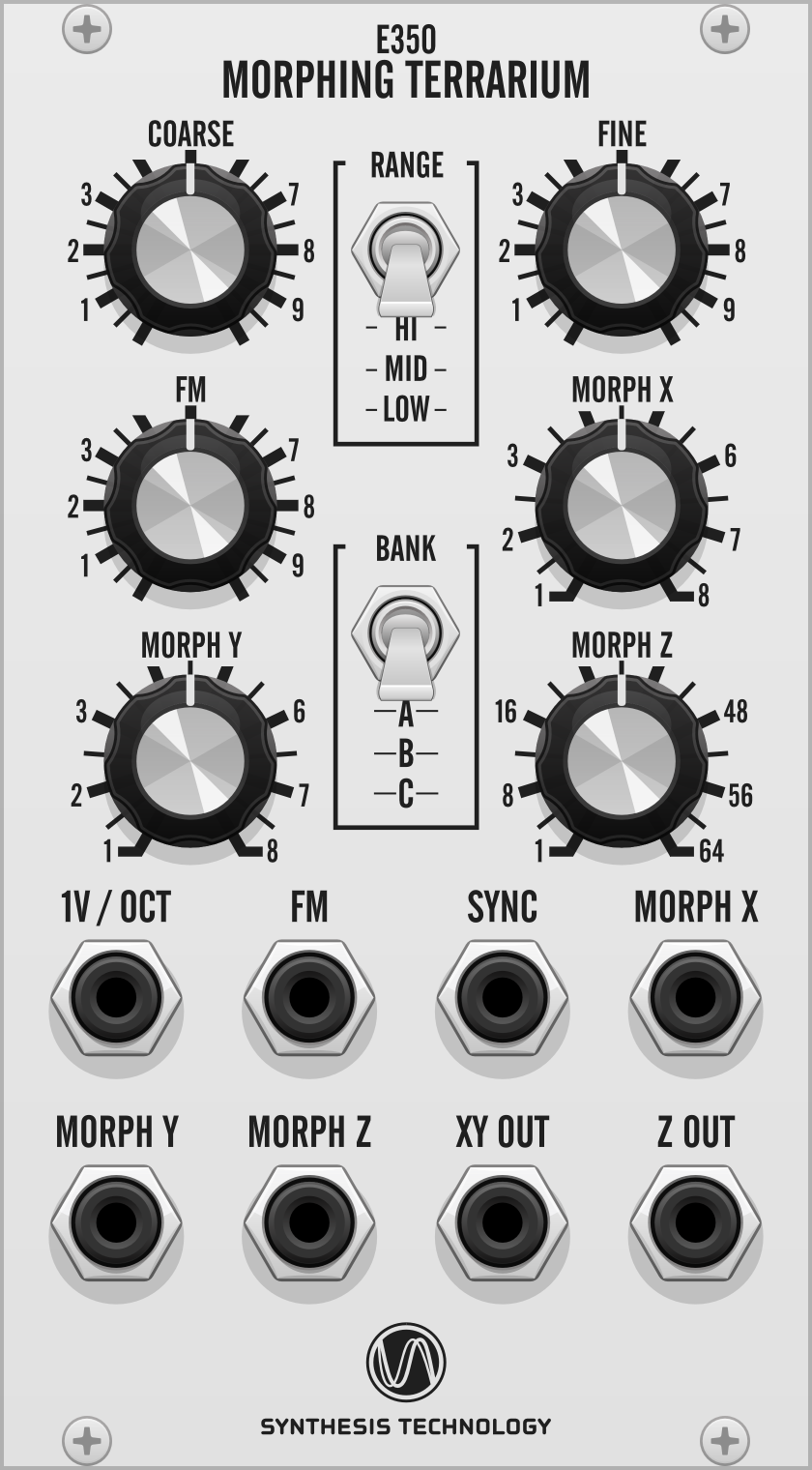
E350 Morphing Terrarium
The Synthesis Technology E350 is a wavetable oscillator with 1D and 2D position modulation, including 3 banks of 64 waveforms. Wavetables are scanned using a glitch-free interpolation algorithm by Synthesis Technology, and the module can operate as an audio-rate VCO or CV-rate LFO.
The BANK switch selects which bank of 64 wavetables to load:
- A (PDF): Sine waves in different harmonic series and a few organ drawbar sets.
- B (PDF): Wide assortment of male/female vocal sets.
- C (PDF): Designed by Robert Rich with diverse LFO/modulation waveforms but can be used in the audio range.
The RANGE switch selects 3 ranges of the COARSE frequency knob:
- HI (audio-rate VCO): 8 Hz to 8300 Hz
- MID (fast LFO): 8 seconds to 130 Hz
- LO (slow LFO): 500 seconds to 2 Hz
The MORPH X and MORPH Y parameters select the wavetable for the XY OUT port, using the bank’s 64 waveforms arranged on an imaginary 8×8 grid.
The MORPH Z parameter selects the wavetable for the Z OUT port, using the bank’s 64 waveforms arranged in a sequential row.
The waveform’s phase can be reset using the SYNC trigger input, which can use another oscillator to produce a sync-lead sound.
Right-click the panel to enable “Phase shift mode”. In this mode, XY OUT plays the Z OUT signal except with an added phase shift (controlled by MORPH X) and attenuation (controlled by MORPH Y). This is useful for adjusting the timing and level of the output signal when used as an LFO source.
This VCV Rack software module uses the original firmware from the hardware Synthesis Technology E350 module. See its manual (PDF) for more details.
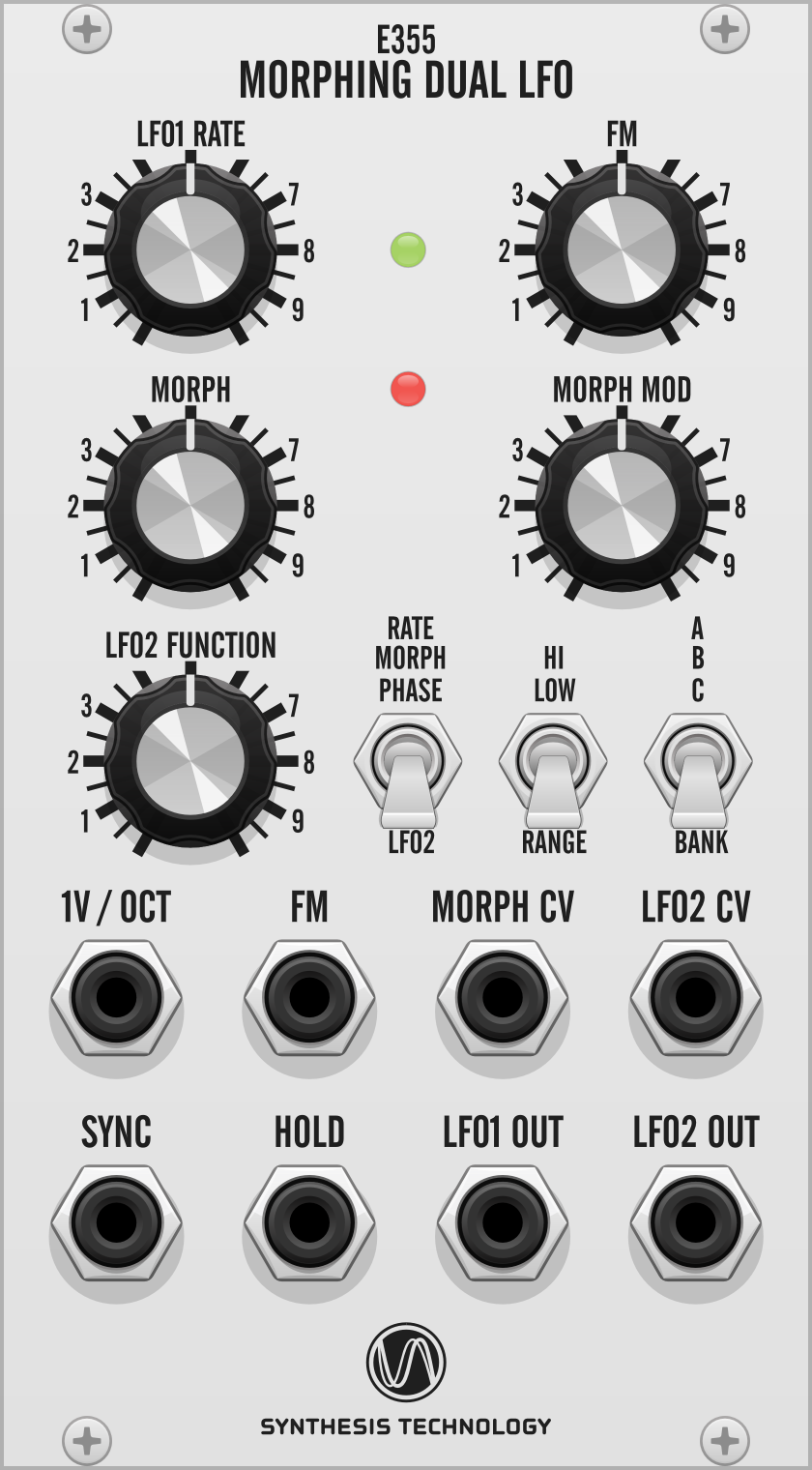
E355 Morphing Dual LFO
The Synthesis Technology E355 is a dual wavetable LFO that generates two related waveforms.
The LFO1 RATE knob sets the frequency of the first LFO, at the LFO1 OUT port. The MORPH knob sets the wavetable position, modulated by the MORPH CV input and MORPH MOD attenuator. The BANK switch selects which of 3 wavetable banks to load.
The second LFO, at the LFO2 OUT port, uses the same frequency, wavetable position (MORPH), and phase as the first LFO, except for the function specified by the LFO2 mode switch. For each mode, the LFO2 FUNCTION knob overrides that particular parameter:
- RATE: LFO2 FUNCTION sets the frequency of LFO2.
- MORPH: LFO2 FUNCTION sets the wavetable position of LFO2.
- PHASE: LFO2 FUNCTION sets the relative phase of LFO2.
The SYNC trigger input resets the phases of both LFOs. The HOLD gate input pauses the phase of both LFOs.
To apply syncing and holding only to LFO1 instead of both LFOs, right-click the panel and set “Sync and hold” to “LFO1”.
This VCV Rack software module uses the original firmware from the hardware Synthesis Technology E355 module. See its manual (PDF) for more details.
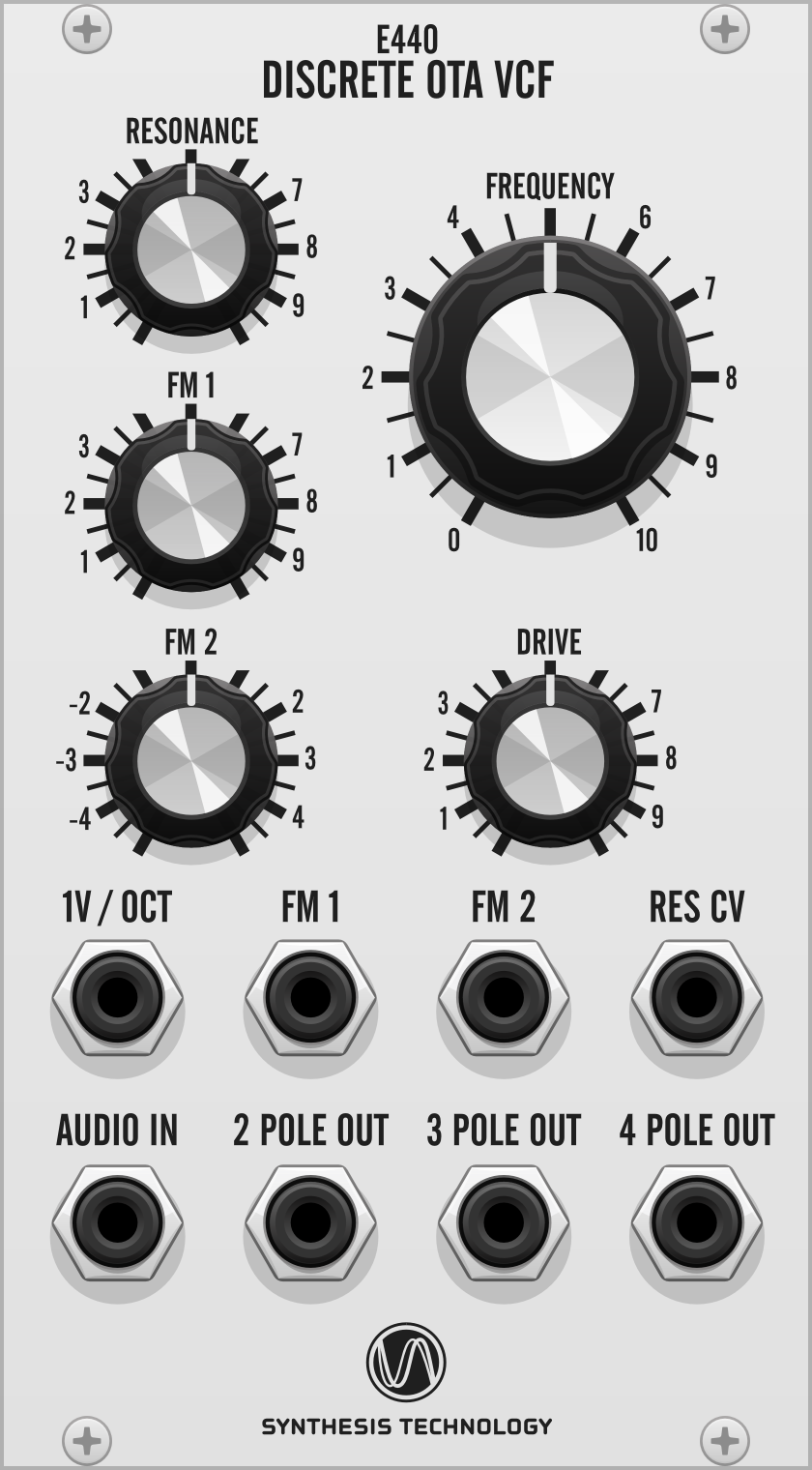
E440 Discrete OTA VCF
The Synthesis Technology E440 models the SSM2040 lowpass filter architecture used in the Prophet 5 Rev 2, the Voyetra 8, and others.
The DRIVE knob applies pre-gain, allowing you to overdrive the filter circuit. There are separate outputs for each filter slope: 2 POLE (12 dB), 3 POLE (18 dB), and 4 POLE (24 dB). The 1V/OCT CV input controls the filter frequency using the 1 V/octave standard, as well as the FM 1 and FM 2 inputs when their attenuation knobs are at their maximum positions.
Right-click the panel and select “Bass boost” to enable an alternate circuit feedback path to boost bass response at high resonance levels. This makes the filter growl and rumble, especially at high resonance.
This VCV Rack software module contains a virtual analog circuit model of the hardware Synthesis Technology E440 module. See its manual (PDF) for more details.
This plugin is dedicated to Paul Schreiber, founder of Synthesis Technology and my friend and mentor. When he and I met online in early 2017, he offered me a job to create WaveEdit for his E370 Kickstarter project. While developing it the following summer, he exposed me to a wonderful world of electronic synthesizer history and its forgotten and lesser-known parts, as well as stories from his career adventures at Tandy and Texas Instruments (which he called Mostly True Tales). We finally met in person at Knobcon 2017 and continued to check in on each other’s lives and businesses through sporadic phone conversations, sometimes lasting all evening during an otherwise slow work day. He passed away in March 2025. I see that his passion lives on in the instruments he’s created, the people he’s inspired, and the music they’ve made. —Andrew Belt
Synthesis Technology Changelog
2.1.1 (2025-10-02)
- E352 & E370: Fix crash when exiting About page in some cases.
2.1.0 (2025-08-16)
- Add E352 and E370.
2.0.4 (2024-04-28)
- Add dark panels.
2.0.3 (2023-07-04)
- E440
- Fix scaling of RES CV input.
- Improve CPU and stability when using high resonance and cutoff.
2.0.2 (2023-06-22)
- E440: Fix noise when using high resonance at high cutoff frequencies.
2.0.1 (2023-06-19)
- E440: Fixed outputs generating silence.
2.0.0 (2023-06-19)
- Initial release of E340, E350, E355, E440.
